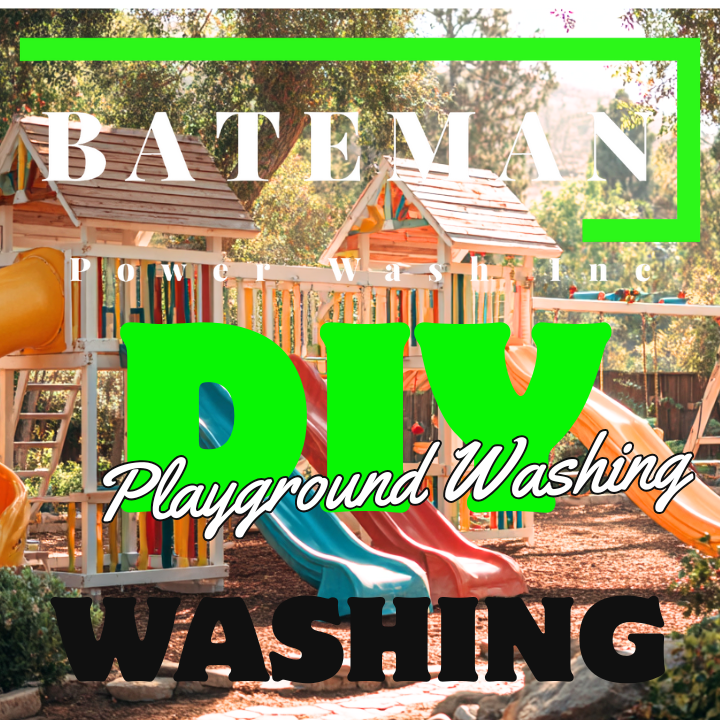Table of Contents
- Introduction: Why Playgrounds Need Regular Cleaning
- Essential Equipment & Tools Checklist
- Choosing the Right Detergent (And What to Avoid)
- Pressure Washer Settings: PSI, GPM, Nozzles Explained
- Prepping the Work Area: Safety & Protection Measures
- Step-by-Step Process to Pressure Wash Playgrounds
- Troubleshooting Common Playground Issues (Mold, Graffiti, Stains)
- Post-Cleaning Treatments for Long-Lasting Results
- Advanced Tips: Speed, Technique, and Avoiding Damage
- Safety Protocols for Technicians
- Maintenance Schedule: How Often Should Playgrounds Be Washed?
- Client Education: What They Should Know Before & After the Service
1. Introduction: Why Playgrounds Need Regular Cleaning
Playgrounds are high-touch, high-traffic areas where children play daily. Dirt, bacteria, algae, bird droppings, and even graffiti accumulate over time, posing safety and health hazards.
Regular professional cleaning ensures playgrounds remain safe, visually appealing, and sanitary, reducing slip hazards and extending the life of play structures.
2. Essential Equipment & Tools Checklist
- Pressure Washer: 1,500 – 2,500 PSI (Lower PSI for plastic/soft surfaces)
- Spray Nozzles:
- 40-degree (White Tip) — For general rinsing
- 25-degree (Green Tip) — For tougher stains
- Soap Nozzle (Black Tip) — For detergent application
- Soft-Bristle Brush or Scrub Pads (Non-abrasive)
- Playground-Safe Detergent (Non-toxic, biodegradable)
- Graffiti Remover (if applicable)
- Garden Hose with Backflow Preventer
- Protective Gear: Safety glasses, gloves, non-slip boots
- Plastic Sheeting & Painter’s Tape (to protect adjacent areas)
3. Choosing the Right Detergent (And What to Avoid)
Ideal Cleaners:
- Non-toxic, biodegradable detergents safe for playground equipment.
- Solutions designed to break down organic growth, dirt, and grime.
- Mild disinfectant properties for high-contact areas.
Avoid:
- Harsh chemicals that can degrade plastic, rubber, or painted surfaces.
- Straight bleach or acidic cleaners that damage coatings and kill surrounding plants.
DIY Mix Example:
- 2 Gallons Warm Water
- 1/3 Cup Gentle Dish Soap
- Optional: 1 Cup White Vinegar (for mildew)
4. Pressure Washer Settings: PSI, GPM, Nozzles Explained
- PSI:
- Plastic Play Equipment: 1,200 – 1,500 PSI
- Metal Structures: Up to 2,500 PSI
- Rubber Safety Surfaces: 1,200 – 1,800 PSI
- GPM: 2.0 – 4.0 GPM for efficient cleaning
- Nozzles:
- 40-degree tip for general playground surface cleaning
- 25-degree tip for graffiti and stubborn grime (use caution)
- Soap tip for detergent application
5. Prepping the Work Area: Safety & Protection Measures
- Inspect equipment for damage (loose bolts, cracks, sharp edges).
- Secure safety signage around the area: “Closed for Cleaning.”
- Cover nearby delicate landscaping with plastic sheeting.
- Pre-soak surrounding grass and plants.
- Remove trash and loose debris before starting.
6. Step-by-Step Process to Pressure Wash Playgrounds
Step 1: Pre-Rinse
- Use a garden hose or 40-degree nozzle to wet the entire playground area.
- This helps soften dirt and prepare surfaces for detergent.
Step 2: Apply Detergent
- Use the soap nozzle to apply a playground-safe cleaning solution.
- Work in sections from bottom to top.
- Allow dwell time of 10-15 minutes (keep the surface wet).
Step 3: Scrub High-Contact Areas
- Use a soft-bristle brush or pad to scrub:
- Handrails
- Slides
- Climbing grips
- Steps and platforms
Step 4: Rinse with Controlled Pressure
- Switch to a 40-degree nozzle.
- Maintain 6-12 inches of distance.
- Rinse top-down, ensuring no detergent residue remains.
- For tougher stains, briefly use a 25-degree nozzle with caution.
Step 5: Final Inspection & Spot Clean
- Walk through and spot-check for any missed grime, algae, or stains.
- Re-treat and gently rinse problem areas.
7. Troubleshooting Common Playground Issues
| Problem | Solution |
|---|---|
| Mold/Mildew Shadows | Increase SH concentration, reapply & dwell |
| Graffiti on Hard Surfaces | Apply graffiti remover, scrub, and rinse |
| Slippery Rubber Surfaces | Use a degreaser safe for rubberized flooring |
| Detergent Residue | Rinse thoroughly with a wide-angle nozzle |
8. Post-Cleaning Treatments for Long-Lasting Results
- Apply a non-toxic surface protectant to high-touch plastic components.
- Suggest anti-graffiti coatings for high-vandalism zones.
- Recommend routine inspections and maintenance agreements.
9. Advanced Tips: Speed, Technique, and Avoiding Damage
- Use dual-operator teams for larger playgrounds: one applies detergent, one rinses.
- Avoid close-range pressure on soft plastics to prevent scarring.
- Maintain a smooth, overlapping spray pattern to prevent streaks.
- Schedule cleanings during off-hours to avoid disrupting public use.
10. Safety Protocols for Technicians
- Always wear eye protection and non-slip boots.
- Clearly mark the playground as “Closed for Cleaning.”
- Never allow children near active work zones.
- Use ground-level cleaning methods when possible to avoid ladder use.
- Shut off equipment immediately if surface damage is observed.
11. Maintenance Schedule: How Often Should Playgrounds Be Washed?
| Environment | Frequency |
| High-Traffic Public Parks | Monthly |
| School Playgrounds | Every 2-3 Months |
| Private Daycare/Yard Playgrounds | Quarterly |
| Humid/Mildew-Prone Areas | Every 2 Months |
12. Client Education: What They Should Know
Before Service:
- Ensure playground is closed to public use.
- Remove loose items (toys, trash bins, etc.).
- Inform staff or community about cleaning schedule.
After Service:
- Allow surfaces to fully dry before reopening.
- Inspect for safety and cleanliness.
- Discuss regular maintenance scheduling.
- Recommend anti-slip treatments for rubber surfaces.

